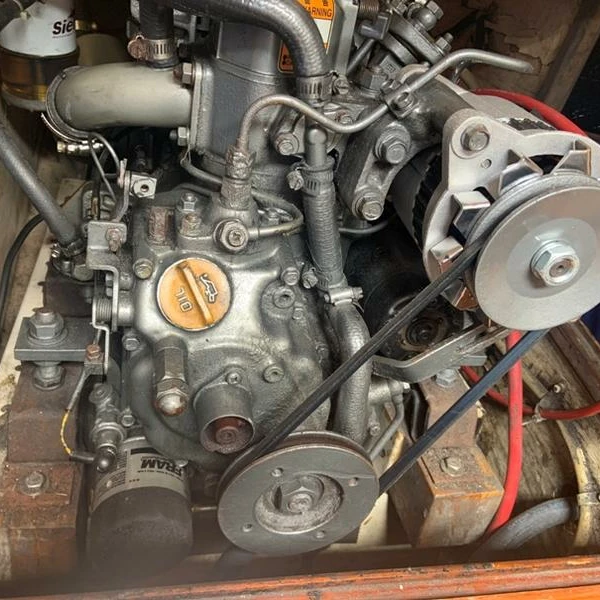Seller's Description
1983 J29 Fractional Rig with inboard engine. Jib Beam just had a complete bottom job including fairing, epoxy barrier coat and VC bottom paint. Boat looks great and has an excellent Triad trailer to move the boat to your location.
Equipment: Engine Yanmar 1GM10 Inboard Diesel with Folding Prop
Sail Inventory 2 Main Sails ( 3 years old or less) 2 Genoa’s ( 3 years old or less) 1 Jib Sheet 2 spinnakers 1 A-Spinnaker 1 Code Zero
Electronics New Depth Finder 2022 New Raymarine i60 Wind Display (2022) Raymarine Electronic Compass Aquatic AVAQ-MP-5BT Waterproof Media Player w/ 4 Speakers VHFMarine Radio Ray Marine Speed Transducer (2021) Dual Battery with Shore Power Connections Xantrex Freedom Inverter Charger w/remote control Panel Speed Puck by Velocitek 2022
Rigging New BackStay 2022 13’ Boom 13’ Spinnaker Pole 12’ Whisker Pole New Harken Headstay Foil 2022 Custom Bow Sprit New Main Sheeting System 2022
Others: Custom Dual Axle Trailer - Triad New Head with 8 Gallon Holding Tank 2021 Stainless steel 3 gallon fuel tank Bilge Pump replaced 2022 New Interior Cushions 2022 All winches rebuilt 2022 with 2 spare Mains Custom winch and tiller covers
Specs
- Designers
- ?
- Builders
- ?
- Associations
- ?
- # Built
- ?
- Hull
- Monohull
- Keel
- ?
- Rudder
- ?
- Construction
- ?
Dimensions
- Length Overall
- 29′ 0″ / 8.8 m
- Waterline Length
- ?
- Beam
- 10′ 11″ / 3.4 m
- Draft
- 5′ 7″ / 1.7 m
- Displacement
- ?
- Ballast
- ?
Rig and Sails
- Type
- ?
- Reported Sail Area
- ?
- Total Sail Area
- ?
Mainsail
- Sail Area
- ?
- P
- ?
- E
- ?
- Air Draft
- ?
Foresail
- Sail Area
- ?
- I
- ?
- J
- ?
- Forestay Length
- ?
Auxilary Power
- Make
- ?
- Model
- ?
- HP
- ?
- Fuel Type
- ?
- Fuel Capacity
- ?
- Engine Hours
- ?
Accomodations
- Water Capacity
- ?
- Holding Tank Capacity
- ?
- Headroom
- ?
- Cabins
- 1
Calculations
- Hull Speed
- ?
Hull Speed
The theoretical maximum speed that a displacement hull can move efficiently through the water is determined by it's waterline length and displacement. It may be unable to reach this speed if the boat is underpowered or heavily loaded, though it may exceed this speed given enough power. Read more.
Formula
Classic hull speed formula:
Hull Speed = 1.34 x √LWL
A more accurate formula devised by Dave Gerr in The Propeller Handbook replaces the Speed/Length ratio constant of 1.34 with a calculation based on the Displacement/Length ratio.
Max Speed/Length ratio = 8.26 ÷ Displacement/Length ratio.311
Hull Speed = Max Speed/Length ratio x √LWL
- Sail Area/Displacement
- ?
Sail Area / Displacement Ratio
A measure of the power of the sails relative to the weight of the boat. The higher the number, the higher the performance, but the harder the boat will be to handle. This ratio is a "non-dimensional" value that facilitates comparisons between boats of different types and sizes. Read more.
Formula
SA/D = SA ÷ (D ÷ 64)2/3
- SA: Sail area in square feet, derived by adding the mainsail area to 100% of the foretriangle area (the lateral area above the deck between the mast and the forestay).
- D: Displacement in pounds.
- Ballast/Displacement
- ?
Ballast / Displacement Ratio
A measure of the stability of a boat's hull that suggests how well a monohull will stand up to its sails. The ballast displacement ratio indicates how much of the weight of a boat is placed for maximum stability against capsizing and is an indicator of stiffness and resistance to capsize.
Formula
Ballast / Displacement * 100
- Displacement/Length
- ?
Displacement / Length Ratio
A measure of the weight of the boat relative to it's length at the waterline. The higher a boat’s D/L ratio, the more easily it will carry a load and the more comfortable its motion will be. The lower a boat's ratio is, the less power it takes to drive the boat to its nominal hull speed or beyond. Read more.
Formula
D/L = (D ÷ 2240) ÷ (0.01 x LWL)³
- D: Displacement of the boat in pounds.
- LWL: Waterline length in feet
- Comfort Ratio
- ?
Comfort Ratio
This ratio assess how quickly and abruptly a boat’s hull reacts to waves in a significant seaway, these being the elements of a boat’s motion most likely to cause seasickness. Read more.
Formula
Comfort ratio = D ÷ (.65 x (.7 LWL + .3 LOA) x Beam1.33)
- D: Displacement of the boat in pounds
- LWL: Waterline length in feet
- LOA: Length overall in feet
- Beam: Width of boat at the widest point in feet
- Capsize Screening
- ?
Capsize Screening Formula
This formula attempts to indicate whether a given boat might be too wide and light to readily right itself after being overturned in extreme conditions. Read more.
Formula
CSV = Beam ÷ ³√(D / 64)
- Beam: Width of boat at the widest point in feet
- D: Displacement of the boat in pounds
This listing is presented by SailboatListings.com. Visit their website for more information or to contact the seller.














